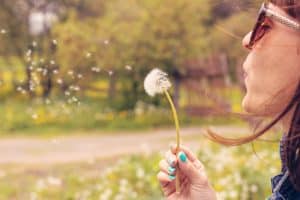You are never given a wish without also being given the power to make it come true.
— Richard Bach
Dandelion is probably the most underappreciated plant that is commonly called a weed, though it has been used for food and medicine for ages and myths and legends have grown up around this colorful, profuse and perverse plant. It is a bright and cheerful indicator that winter is over, spring is here and, believe or or not, is one of the earliest sources of pollen for honeybees.
Dandelions are common all over the world with varieties native to Asia, Europe and North America. The leaves are long and deeply serrated forming a basal rosette that emerges directly from the Earth above a long central tap root. The flowers that appear on a single shoot (hollow with milky white sap) are bright yellow composite flowers made of many florets. The dandelion flower opens an hour after sunrise and closes at dusk giving rise to the belief that it is a “Shepherd’s clock”. After the flowers are spent the “puff” appears with many seeds topped with white “Parachutes” that carry the seeds on the air.
The dandelion is masculine in action and associated with the planet Jupiter, the element of Air and the zodiac signs of Pisces and Sagittarius.
Despite its low status as a weed, it is a well-established medicinal plant. The name dandelion comes from the French “dent de lion” which means “tooth of the lion” referring to the jagged, toothlike leaves. The modern French name, however, is “pissenlit”, which means “to wet the bed” that reflects dandelion’s diuretic properties. But unlike many other diuretics which leach potassium from the body, dandelion actually increases the potassium levels of those who use it. The dandelion’s Latin name is Taraxacum Officinale, which means “the official remedy for disorders.” Early settlers brought the plant to America from Europe, for eating and medicinal purposes, providing nutrients which are hard to find during the winter.
Dandelion is packed with vitamins and minerals, notably vitamins A, B, C, D, Iron, potassium and calcium. The root is an extremely effective detoxifying herb, assisting both the liver and kidneys, as well as the gallbladder and often is grounded for a coffee-like drink.
The leaves are used as a potent blood builder and general strengthening tonic due to their high vitamin and mineral content.
Dandelion can have major therapeutic benefits for those suffering from issues
like acne, anemia, eczema, constipation, gallstones, gout, osteoarthritis, and
psoriasis, as well as numerous other conditions. Both the leaves and root can
be juiced or dried and made into capsules, teas or tinctures.
Fresh leaves are really good bitter liver tonics that you can easily add to salads or stir fries. Make sure that you get organic dandelions, chop together with lettuce or romaine hearts, add avocado, pour over some olive oil and squeeze a bit of lemon.
The Dandelion has been symbolic to a variety of cultures over the years and has been popular in folklore and legends. Considered ordinary and plain when compared to showier blooms like the roses and lotus, it makes up for it with its unique geometry. Its distinctive look is what makes it irresistible as a child, and since most of us have blown a dandelion at some point, we know how amazing and magical it is to watch the fluffy dandelion seeds fly through the air. We all know that if you made a wish and blew dandelion seeds into the wind, your wish will come true. In this sense, dandelions can be associated with hope and dreams that may come true.
Dandelion can be a symbol of life. It is a plain and unimpressive weed, nearly impossible to remove because of its spectacularly strong roots. Then, when it goes to seed, it is suddenly beautiful, fluffy and white, standing proudly above the grass and weeds. But then finally, one strong wind and its beautiful geometry is gone.
The flower essence of Dandelionis a detoxifier that works on the emotional and mental being of a person bringing the dynamic, effortless energy and works on balancing tension, especially in musculature of the body. Flower essence society recommends Dandelion to individuals that are compulsive “doers” who enter with great zeal and zest into many activities. Unfortunately, they can over-plan and over-form their lives beyond the natural capacity of the body to sustain such intensity. Furthermore, such persons may become unable to experience more contained moments of reflective activity. The unexpressed inner life of the soul and the harsh demands on the body collide to create extreme tension, especially in the musculature. The Dandelion flower teaches these individuals how to listen more closely to emotional messages and bodily needs. As tension is released the soul feels more inner ease and balance, allowing spiritual forces to flow through the body in a dynamic, effortless way.
According to Scott Cunningham, author of multiple books on herbs and Wicca, Dandelion is said to increase psychic abilities when taken as a tea. A tea of the roots left steaming and placed beside the bed will call in the spirits and Dandelion buried in the northwest corner of the house will bring favorable winds.
If for some reason you become drawn to dandelion, it comes to your dreams or tries to grab your attention any other peculiar way, consider thinking of its symbolism and energetic properties. See if it’s the right remedy for you at this time on a physical, spiritual or emotional level.
Anna Bazarnaya with Maitri Verde provides consultations, aromatherapy, flower essences, and aromatic distillations. She can be reached at anna@maitriverde.com , (415) 450 0947


